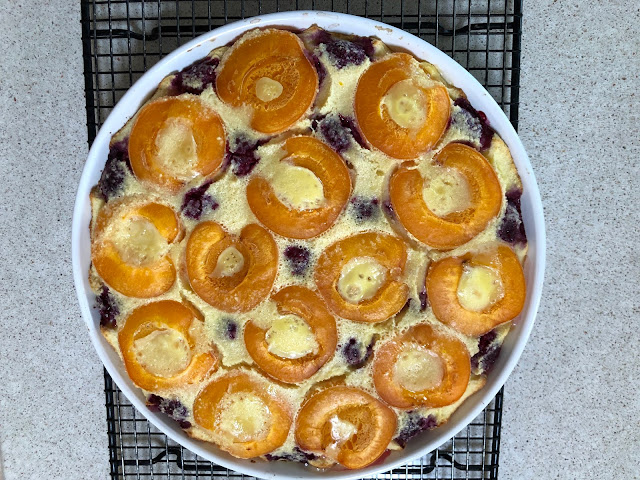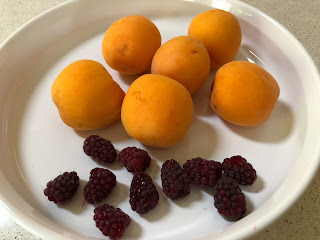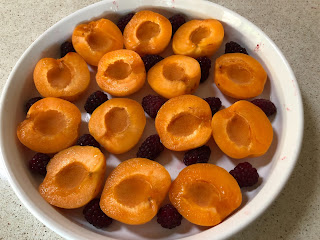
Recipe: Showcase apricots and berries in an easy dessert
 |
| Apricots and loganberries are baked in an eggy batter for clafoutis. (Photos: Kathy Morrison) |
Apricots have such a short season locally that you have to move fast if you want to bake with them.
Apricot pie is a natural, of course, but I've learned something about that over the years: Apricot pie tastes best if you peel the apricots first. Otherwise, a slight bitterness lingers.
If you're not up to peeling apricots, and I don't blame you, instead bake a clafoutis, a wonderful fruit-centric dessert that lands somewhere between custard and cake. The bitterness isn't concentrated here, and you don't need nearly as many precious apricots.

I wound up using one more apricot and about eight more berries |
The clafoutis' culinary ancestry is in France, where it traditionally is made with whole, unpitted cherries. (Gotta warn people when you do that.)
But really any fresh fruit can go into a clafoutis. The key is a wide, flat tart pan (a large pie pan also works) and room-temperature eggs and milk. Pour the batter around the fruit and pop it in the oven for a dessert that also works as a brunch dish. You can even eat it cold, in the unlikely event there are leftovers.
This particular version was determined by the fruit available at the Saturday farmers market. One vendor, from Apple Hill, had loganberries and tayberries along with his gorgeous blueberries. I bought some of the loganberries (a cross between blackberries and raspberries) to add color to the clafoutis. The other berries would have worked, too. Cherries also play well with apricots, though I prefer to pit them.
The recipe is adapted from several sources, including three versions on the New York Times Cooking site.

The fruit's ready for the batter to be added. I poured it in
from the side to prevent disturbing my fruit pattern
|
Apricot and loganberry clafoutis
Serves 4 to 6
Ingredients:
Butter for pan
6 to 7 fresh apricots (about 1 pound)
1/2 cup (or more) fresh berries
1 1/4 cups whole milk, room temperature
3 eggs, room temperature
1 teaspoon vanilla extract
1/3 cup all-purpose flour
1/3 cup almond flour
6 tablespoons granulated sugar
Pinch sea salt
Instructions:
Preheat oven to 375 degrees. Butter a 10-inch ceramic tart pan or pie plate. (A deep 9-inch pan will work, but the clafoutis may take longer to bake.)
Halve and pit the apricots, and lay them cut side up in one layer in the prepared pan. You may need one more apricot or one fewer, depending on the size of the pan. Distribute the berries evenly among the apricot halves. Set pan aside while you make the batter.
Beat the milk and the eggs together in a bowl or large measuring cup, then blend in the vanilla extract. Whisk in the flours, then the sugar and salt, until thoroughly blended.
Pour the batter into the pan around the fruit. Carefully transfer the pan to the oven. Bake 35 to 40 minutes until the clafoutis is light golden brown and puffed. Remove to a rack and let cool 10 minutes before cutting and serving. (Clafoutis may deflate just a bit during cooling.) Or allow to cool completely before serving.
Comments
0 comments have been posted.Sacramento Digs Gardening to your inbox.
Food in My Back Yard Series
May 6: Maintain soil moisture with mulch for garden success
April 29: What's (already) wrong with my tomato plants?
April 22: Should you stock up on fertilizer? (Yes!)
April 15: Grow culinary herbs in containers
April 8: When to plant summer vegetables
April 1: Don't be fooled by these garden myths
March 25: Fertilizer tips: How to 'feed' your vegetables for healthy growth
March 18: Time to give vegetable seedlings some more space
March 11: Ways to win the fight against weeds
March 4: Potatoes from the garden
Feb. 25: Plant a fruit tree now -- for later
Feb. 18: How to squeeze more food into less space
Feb. 11: When to plant? Consider staggering your transplants
Feb. 4: Starting in seed starting
Sites We Like
Garden Checklist for week of May 4
Enjoy this spring weather – and get gardening!
* Plant, plant, plant! It’s prime planting season in the Sacramento area. Time to set out those tomato transplants along with peppers and eggplants. Pinch off any flowers on new transplants to make them concentrate on establishing roots instead of setting premature fruit.
* Direct-seed melons, cucumbers, summer squash, corn, radishes, pumpkins and annual herbs such as basil.
* Harvest cabbage, lettuce, peas and green onions.
* In the flower garden, direct-seed sunflowers, cosmos, salvia, zinnias, marigolds, celosia and asters. (You also can transplant seedlings for many of the same flowers.)
* Plant dahlia tubers. Other perennials to set out include verbena, coreopsis, coneflower and astilbe.
* Transplant petunias, marigolds and perennial flowers such as astilbe, columbine, coneflowers, coreopsis, dahlias, rudbeckia and verbena.
* Keep an eye out for slugs, snails, earwigs and aphids that want to dine on tender new growth.
* Feed summer bloomers with a balanced fertilizer.
* For continued bloom, cut off spent flowers on roses as well as other flowering plants.
* Add mulch to the garden to maintain moisture. Mulch also cuts down on weeds. But don’t let it mound around the stems or trunks of trees or shrubs. Leave about a 6-inch to 1-foot circle to avoid crown rot or other problems.